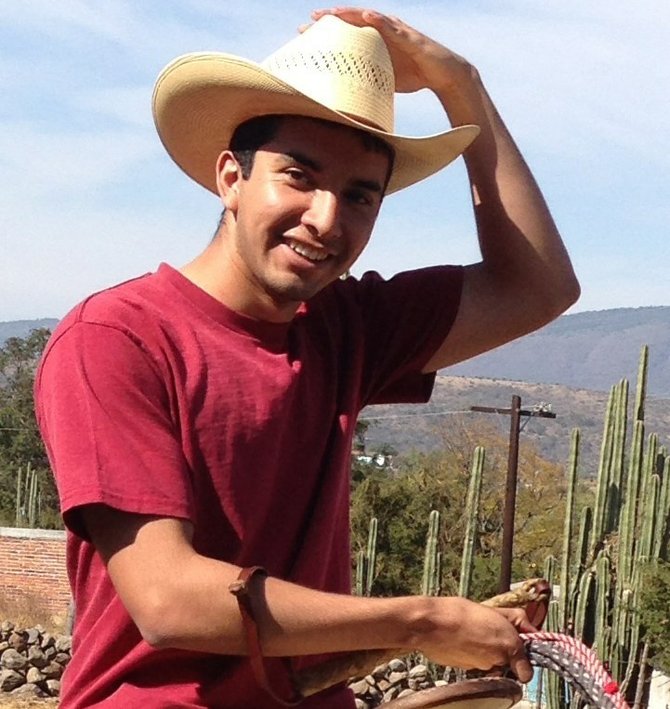 Facebook
Facebook
 X
X
 Instagram
Instagram
 TikTok
TikTok
 Youtube
Youtube

The May 17 drug-overdose death of UCSD undergraduate computer-science student Ricardo "Ricky" Ambriz continues to quietly shake the foundations of UCSD, with administrators in a behind-the-scenes struggle over the fate of the Sun God Festival, an annual rock concert and drinking spree held by the school each spring.
An autopsy released by the county medical examiner showed Ambriz died of an overdose of 5-APB, also called "benzofury,” a chemical variant of Methylenedioxyamphetamine, otherwise known as MDA.
According to the report, Ambriz began exhibiting symptoms upon departing the Sun God grounds. "After leaving the festival at midnight, his friend noticed him to ‘freeze’ at times during their walk back to their apartment. The friend also stated he was 'starting to reach out into the air grabbing at stuff.' He had clenched teeth and was having difficulty breathing."
Ambriz's alcohol level was a relatively modest .02, not enough to kill him, the autopsy found, but booze and other drugs were still a major problem for the festival, if not quite as bad as last year, according to documents released by the university after a request under the California Public Records Act.
The improvement resulted in part from a heavy contingent of cops, uniformed and undercover, federal and local, the documents say. Costs to taxpayers of the formidable force and its numbers were not revealed.

"We received assistance from 15 law enforcement agencies, and were scheduled to have 57% more hours of police service throughout the day," said a May 17 postmortem of this year's Sun God by Alan Houston, the school’s interim vice chancellor for student affairs and a political science professor.
"We also had significantly more StaffPro present, especially in north campus and on the field. (I do not know the precise number of StaffPro.)
"The no-guest policies we implemented at The Village and I-House appear to have their intended effect; both areas were calm throughout the day, and neither saw the kind of parties witnessed in recent years.
“The no-host policy we implemented throughout the campus also appears to have been effective; the college communities were also calmer than in the past.
"Subjectively, those who have staffed previous events said that this year’s Sun God was calmer and quieter, that fewer students appeared to be intoxicated, etc."
Houston went on to report that the university "saw approximately 58 students in detox (2013 saw 96; 2012 saw 71)" and "had approximately 16 hospitalizations, including those sent from detox level 2 (2013 saw 48; 2012 saw 21)."
A medically monitored detox center set up on the campus "saw approximately 20 students, 5 of who were ultimately transported to the hospital, while 15 were released (this facility was new this year, so we have no comparative data)."
The email noted that Ambriz had died in the morning but contained no details.
Three days later it was time for some damage control regarding coverage of the tragedy by the school newspaper.
Wrote Houston in a May 20 email to UCSD chief public relations honcho Jeff Gattas, "the Guardian keeps printing things that are incorrect and misleading. And I’m hearing from students across campus that they need clear signals about what is being done.
"The answer is, 'a lot'; attached is a working list of support programs and activities that we started yesterday and are continually updating."
Then Houston added, "It’s not designed for public consumption.”
"But what do you think about arranging an interview with the Guardian to discuss those parts that are? I think it would be reassuring to students — and productive in this context — to spread this information.
"Please let me know if this makes sense, and if so, how you would like me to proceed."
If Gattas responded by email, the document was not provided by the school.


The May 17 drug-overdose death of UCSD undergraduate computer-science student Ricardo "Ricky" Ambriz continues to quietly shake the foundations of UCSD, with administrators in a behind-the-scenes struggle over the fate of the Sun God Festival, an annual rock concert and drinking spree held by the school each spring.
An autopsy released by the county medical examiner showed Ambriz died of an overdose of 5-APB, also called "benzofury,” a chemical variant of Methylenedioxyamphetamine, otherwise known as MDA.
According to the report, Ambriz began exhibiting symptoms upon departing the Sun God grounds. "After leaving the festival at midnight, his friend noticed him to ‘freeze’ at times during their walk back to their apartment. The friend also stated he was 'starting to reach out into the air grabbing at stuff.' He had clenched teeth and was having difficulty breathing."
Ambriz's alcohol level was a relatively modest .02, not enough to kill him, the autopsy found, but booze and other drugs were still a major problem for the festival, if not quite as bad as last year, according to documents released by the university after a request under the California Public Records Act.
The improvement resulted in part from a heavy contingent of cops, uniformed and undercover, federal and local, the documents say. Costs to taxpayers of the formidable force and its numbers were not revealed.

"We received assistance from 15 law enforcement agencies, and were scheduled to have 57% more hours of police service throughout the day," said a May 17 postmortem of this year's Sun God by Alan Houston, the school’s interim vice chancellor for student affairs and a political science professor.
"We also had significantly more StaffPro present, especially in north campus and on the field. (I do not know the precise number of StaffPro.)
"The no-guest policies we implemented at The Village and I-House appear to have their intended effect; both areas were calm throughout the day, and neither saw the kind of parties witnessed in recent years.
“The no-host policy we implemented throughout the campus also appears to have been effective; the college communities were also calmer than in the past.
"Subjectively, those who have staffed previous events said that this year’s Sun God was calmer and quieter, that fewer students appeared to be intoxicated, etc."
Houston went on to report that the university "saw approximately 58 students in detox (2013 saw 96; 2012 saw 71)" and "had approximately 16 hospitalizations, including those sent from detox level 2 (2013 saw 48; 2012 saw 21)."
A medically monitored detox center set up on the campus "saw approximately 20 students, 5 of who were ultimately transported to the hospital, while 15 were released (this facility was new this year, so we have no comparative data)."
The email noted that Ambriz had died in the morning but contained no details.
Three days later it was time for some damage control regarding coverage of the tragedy by the school newspaper.
Wrote Houston in a May 20 email to UCSD chief public relations honcho Jeff Gattas, "the Guardian keeps printing things that are incorrect and misleading. And I’m hearing from students across campus that they need clear signals about what is being done.
"The answer is, 'a lot'; attached is a working list of support programs and activities that we started yesterday and are continually updating."
Then Houston added, "It’s not designed for public consumption.”
"But what do you think about arranging an interview with the Guardian to discuss those parts that are? I think it would be reassuring to students — and productive in this context — to spread this information.
"Please let me know if this makes sense, and if so, how you would like me to proceed."
If Gattas responded by email, the document was not provided by the school.
Comments